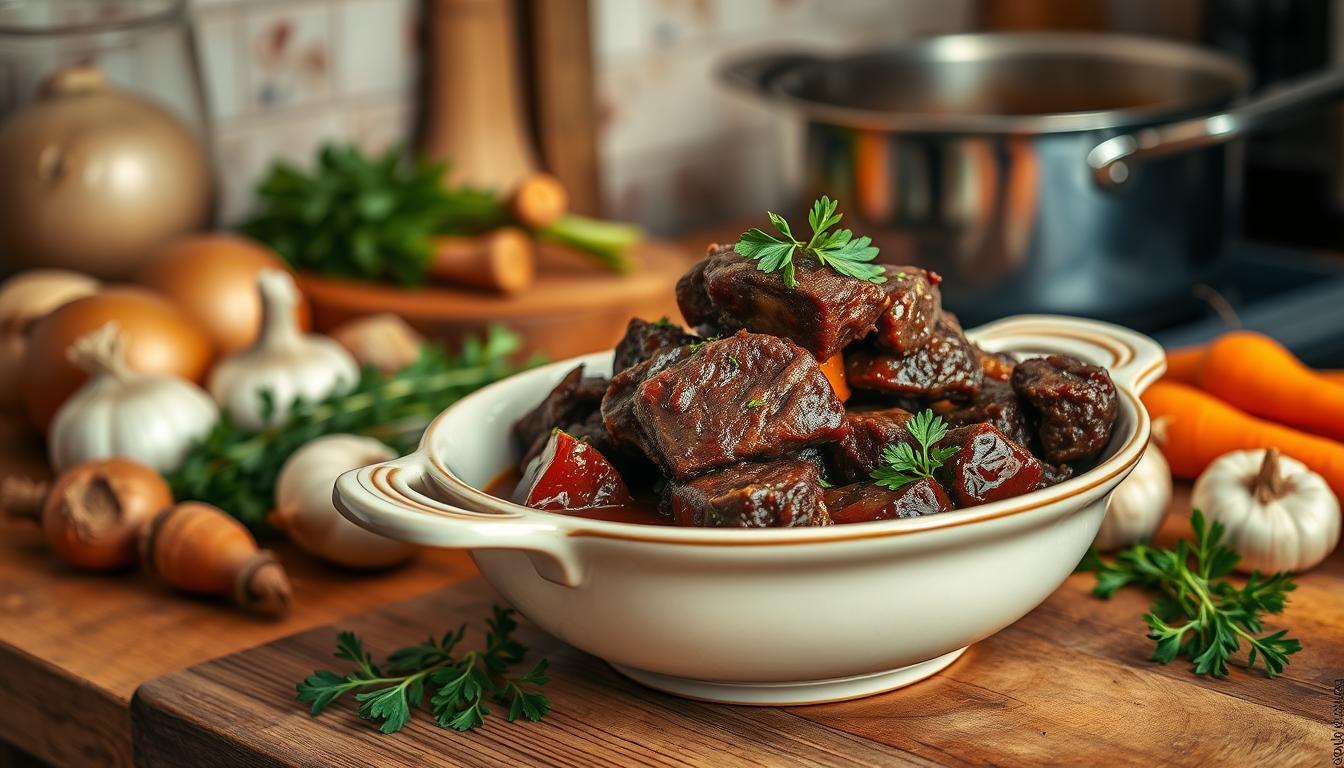Welcome to your ultimate cooking masterclass on beef cheeks. Here, you’ll discover the culinary magic of this often-overlooked cut of meat. You’ll explore various beef cheeks recipes that can turn this meat into a masterpiece.
In this article, you’ll learn all about beef cheeks. From what they are and where to find them, to mastering cooking techniques and pairing them with sides and sauces. Whether you’re a pro chef or a home cook, this guide will help you impress your family and friends with beef cheeks dishes.
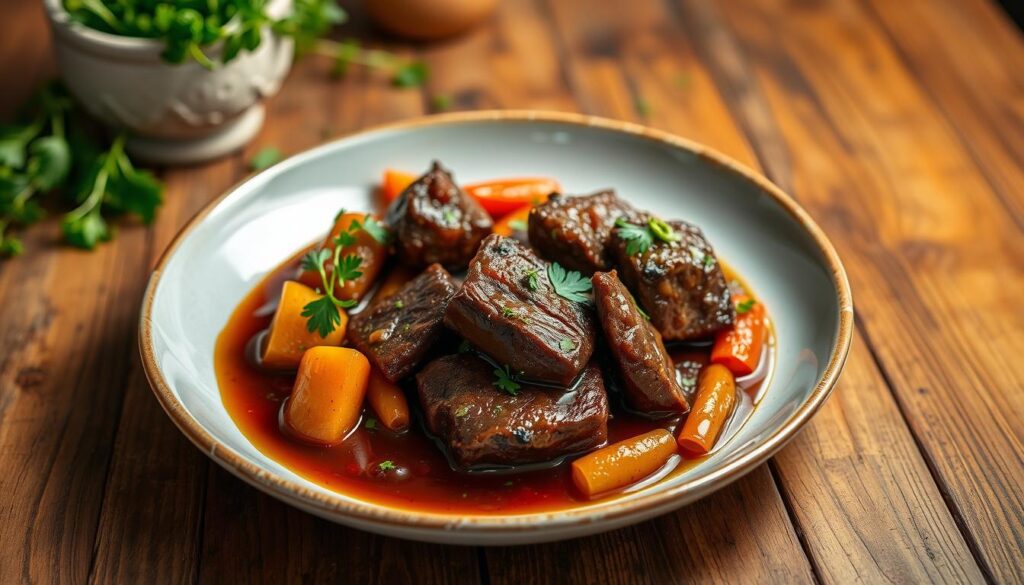
Introduction to Beef Cheeks
Get ready for a culinary adventure that will elevate your cooking skills. You’ll explore the best beef cheeks recipes and techniques. With the right knowledge, you can create dishes that will wow your loved ones.
- You will learn about the culinary magic of beef cheeks and how to cook them perfectly with various recipes.
- You will discover the best techniques for mastering beef cheeks, including cooking methods and sauce pairings.
- You will understand how to pair beef cheeks with complementary sides and sauces for a complete meal.
- You will learn about the different types of beef cheeks recipes and how to choose the right one for your taste.
- You will gain confidence in your cooking skills and be able to impress your family and friends with your creations.
- You will have access to a wide range of beef cheeks recipes and cooking techniques to try at home.
Understanding Beef Cheeks: A Premium Cut
Beef cheeks are a delicacy that offers a unique culinary experience. To appreciate their value, it’s essential to understand what they are and their nutritional benefits. When looking for where to buy beef cheeks, consider visiting specialty butcher shops or high-end grocery stores that carry premium cuts of meat.
Beef cheeks are known for their rich, beefy flavor and tender texture when cooked properly. They offer a unique nutritional profile, being high in protein and low in fat, making them an attractive option for health-conscious foodies. Chefs love this cut because of its versatility and the depth of flavor it adds to dishes. Whether you’re looking for a new ingredient to elevate your stews or a centerpiece for a special occasion, beef cheeks are an excellent choice. You can find various beef cheeks recipes online, from traditional braises to modern twists on classic dishes.
Some key benefits of beef cheeks include:
- High protein content
- Low fat content
- Rich, beefy flavor
- Versatile in cooking methods
When cooking with beef cheeks, it’s essential to consider the cooking method and recipe. With the right technique and ingredients, you can create a dish that’s both delicious and nutritious. For those interested in exploring beef cheeks recipes, there are many resources available online, including cookbooks and food blogs. By understanding the basics of beef cheeks and their nutritional benefits, you can unlock a world of culinary possibilities and find the perfect where to buy beef cheeks to suit your needs.
Where to Buy Beef Cheeks and What to Look For
Wondering where to find top-notch beef cheeks? You can check out specialty butcher shops, upscale grocery stores, or farmers’ markets. Look for fresh, evenly fat beef cheeks from a trusted source.
Some top spots to buy beef cheeks include:
- Specialty butcher shops, which often carry a variety of premium cuts
- High-end grocery stores, which may have a dedicated meat counter with knowledgeable staff
- Farmers’ markets, where you can find fresh, locally sourced beef cheeks from local farmers
When buying beef cheeks, focus on quality and origin. Freshness and fat distribution matter a lot. Ask the butcher or seller about the beef’s origin and quality to get the best.
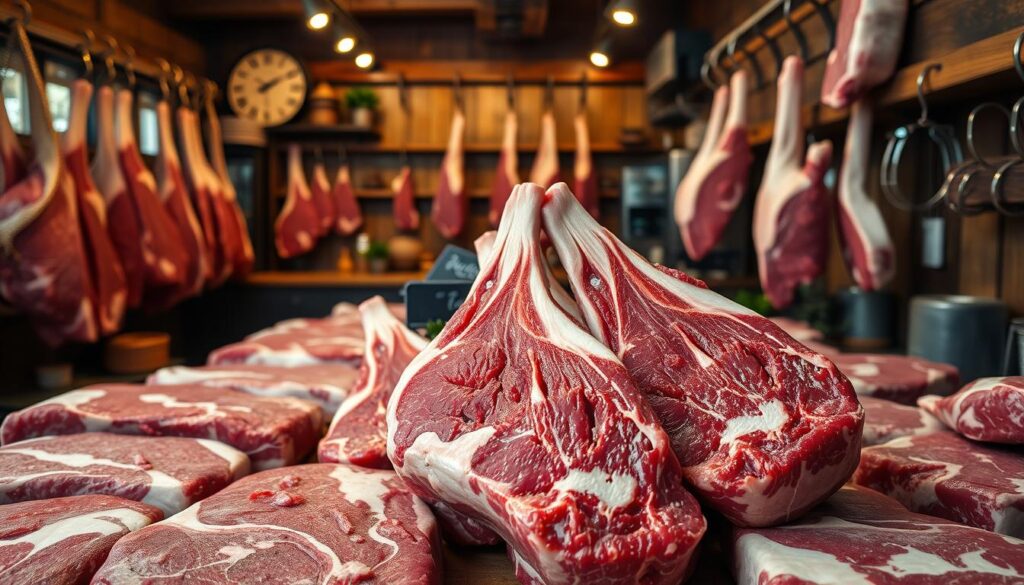
Take your time to pick the best beef cheeks for your dish. With some knowledge, you can find great beef cheeks and make a memorable meal. Whether you’re a pro chef or a home cook, knowing where to buy and what to look for will improve your cooking.
| Source | Quality | Freshness |
|---|---|---|
| Specialty butcher shops | Premium | High |
| High-end grocery stores | High-end | Fresh |
| Farmers’ markets | Locally sourced | Very fresh |
Essential Preparation Techniques for Beef Cheeks
Proper preparation is key to tender and flavorful beef cheeks. Start by trimming and cleaning the meat. Remove excess fat and connective tissue. This ensures even cooking and avoids tough bits.
After cleaning, marinating is next. Marinating adds flavor and tenderizes the meat. Try olive oil, garlic, and herbs, or vinegar or lemon juice. Experimenting with marinades is important to find your favorite.
Trimming and Cleaning
- Remove excess fat and connective tissue from the beef cheeks
- Rinse the beef cheeks under cold water to remove any impurities
- Pat the beef cheeks dry with paper towels to help them brown more evenly
Marinating Methods
Marinating adds flavor and tenderizes the meat. Use olive oil, garlic, and herbs, or vinegar or lemon juice. Experimenting with marinades is key to finding your favorite.
Follow these steps for delicious and tender beef cheeks. Handle the meat gently and cook it low and slow. With practice, you’ll master cooking beef cheek meat.
Mastering Slow-Cooker Beef Cheeks
Cooking beef cheeks in a slow cooker is all about the basics. It’s a method that cooks the meat slowly, making it tender and full of flavor. To get it right, you need to think about liquid levels, cooking times, and the role of aromatics.
Some benefits of cooking beef cheeks in a slow cooker include:
- Easy to prepare and requires minimal supervision
- Allows for a wide range of flavor profiles and ingredients
- Results in tender, fall-apart meat that’s perfect for a variety of dishes
To start cooking beef cheeks in a slow cooker, pick a recipe you like. You can choose from braised beef cheeks with red wine and mushrooms, spicy beef cheeks with chipotle peppers, or classic beef cheeks with carrots and potatoes.
Remember, the quality of your ingredients and the tenderness of the beef cheeks matter a lot. With patience and practice, you’ll get better at cooking beef cheeks in a slow cooker. Soon, you’ll enjoy delicious, satisfying meals.
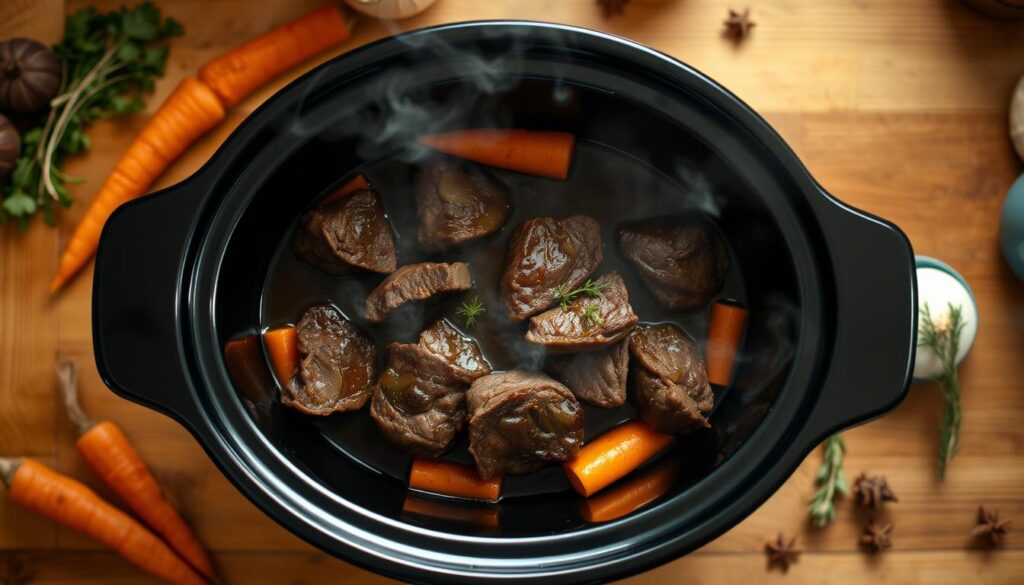
By following these tips, you’ll make mouth-watering slow-cooked beef cheeks. These dishes will impress your friends and family. Whether you’re experienced or new to cooking, slow-cooking beef cheeks is a skill worth mastering.
| Recipe | Cooking Time | Ingredients |
|---|---|---|
| Braised Beef Cheeks | 8 hours | beef cheeks, red wine, mushrooms, onions |
| Spicy Beef Cheeks | 6 hours | beef cheeks, chipotle peppers, adobo sauce, garlic |
| Classic Beef Cheeks | 10 hours | beef cheeks, carrots, potatoes, onions |
Traditional Braising Methods for Tender Beef Cheeks
Cooking beef cheeks with traditional braising methods is a great way to get tender and flavorful results. A good recipe will show you how to slow-cook the meat in liquid over low heat. This method is perfect for beef cheeks because it breaks down the meat and infuses it with rich flavors.
There are many traditional braising methods to choose from. You can try a classic French method with red wine and mushrooms, or an Asian-inspired method with soy sauce and ginger. Wine-based braising techniques are also popular, adding complexity to the dish.
Classic French Braising
This method cooks the beef cheeks in red wine, stock, and aromatics like onions and carrots. The result is a rich, flavorful sauce that’s great over mashed potatoes or egg noodles.
Asian-Inspired Braising
This method uses Asian flavors like soy sauce, ginger, and five-spice powder. The beef cheeks are cooked in a mix of stock, soy sauce, and rice vinegar, creating a sweet and savory sauce.
Wine-Based Braising Techniques
This method cooks the beef cheeks in a mix of red wine, stock, and aromatics. The result is a tender, flavorful dish perfect for special occasions.
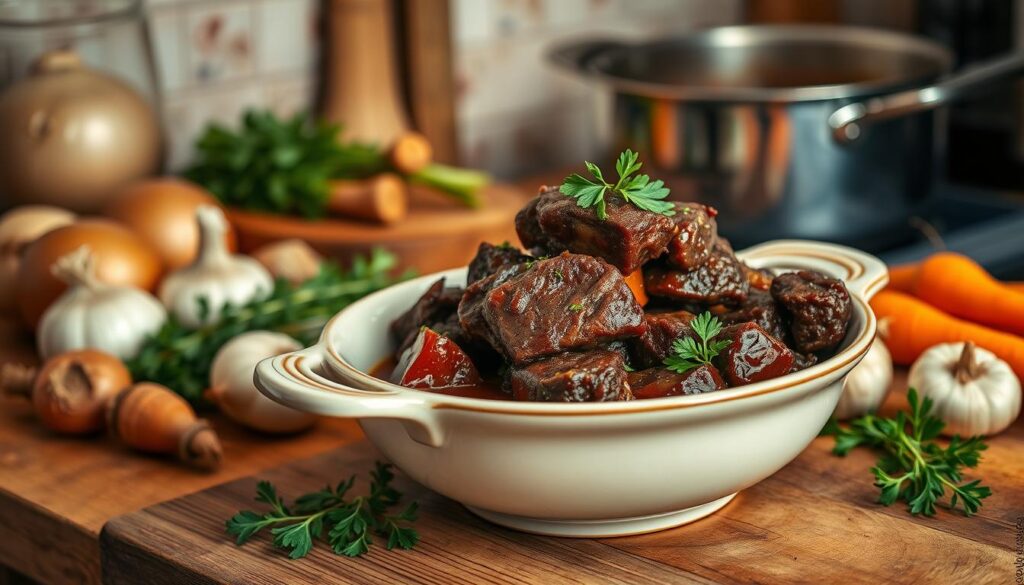
Mastering these traditional braising methods will help you create a delicious beef cheeks recipe. Whether you choose a classic French method or an Asian-inspired one, the key is to cook the meat low and slow. This allows the flavors to meld together and the meat to become tender and fall-apart.
| Braising Method | Ingredients | Cooking Time |
|---|---|---|
| Classic French | Red wine, stock, onions, carrots | 2-3 hours |
| Asian-Inspired | Soy sauce, ginger, five-spice powder, stock | 1-2 hours |
| Wine-Based | Red wine, stock, aromatics | 2-3 hours |
Troubleshooting Common Beef Cheek Cooking Challenges
When cooking beef cheeks in a slow cooker, you might face some common issues. One big problem is tough, chewy meat. This often happens if the meat isn’t cooked enough or if the connective tissue doesn’t break down well. To fix this, try cooking the meat for longer or use a strong marinade. For instance, marinate the beef cheeks in olive oil, garlic, and herbs for a few hours before cooking.
Another issue is when the meat lacks flavor. You can solve this by tweaking the seasoning or adding more aromatics. Try adding onions, carrots, and celery to the slow cooker with the beef cheeks for extra taste. How to cook beef cheek meat to perfection takes some trial and error. By knowing how to tackle these common problems, you can make sure your beef cheek dishes always come out right.
Here are some tips to help you troubleshoot common beef cheek cooking challenges:
- Use a meat thermometer to ensure the beef cheeks are cooked to a safe internal temperature.
- Don’t overcrowd the slow cooker, as this can prevent the beef cheeks from cooking evenly.
- Add some acidity, such as tomato paste or vinegar, to help break down the connective tissue.
By following these tips and practicing how to cook beef cheek meat, you can become a pro at cooking beef cheeks in a slow cooker. Always use fresh, high-quality ingredients. Don’t hesitate to try different seasonings and marinades. With time and practice, you’ll make delicious, tender beef cheek dishes that will wow your loved ones.
| Common Challenge | Solution |
|---|---|
| Tough, chewy meat | Increase cooking time or use a more aggressive marinade |
| Lack of flavor | Adjust seasoning or add more aromatics during cooking |
Complementary Sides and Sauce Pairings
Beef cheeks recipes get even better with the right sides and sauces. Choose from mashed potatoes, roasted veggies, or polenta to complement the beef cheeks’ rich taste.
A great sauce can enhance your beef cheeks. Try simple pan sauces or complex reductions to match the beef’s bold flavors. Options include red wine reduction, mushroom gravy, or demiglace.
Traditional Side Dishes
- Mashed potatoes
- Roasted vegetables
- Polenta
- Sauteed spinach
Sauce Recommendations
- Red wine reduction
- Mushroom gravy
- Demiglace
- Balsamic glaze
Wine Pairing Suggestions
Full-bodied reds like Cabernet Sauvignon or Syrah pair well with beef cheeks. For a contrast, try a crisp white wine like Sauvignon Blanc or Pinot Grigio.
| Wine | Pairing Suggestions |
|---|---|
| Cabernet Sauvignon | Beef cheeks with red wine reduction |
| Sauvignon Blanc | Beef cheeks with roasted vegetables |
Conclusion: Mastering the Art of Beef Cheek Cookery
Your journey through beef cheeks has been a true culinary adventure. You’ve learned about this premium cut and how to cook it. Now, you can turn this humble ingredient into a mouthwatering masterpiece.
As you keep exploring beef cheek recipes, remember a few key things. Be patient, adaptable, and open to new flavors and approaches. This will help you succeed in your cooking.
Whether you like the classic French braising method or a bold Asian twist, beef cheeks offer endless possibilities. Embrace challenges, trust your instincts, and don’t be afraid to try new things. With each dish, you’ll discover new flavors and textures, making you a true beef cheek connoisseur.
The art of beef cheek cookery is a journey, not a destination. Enjoy the process, try different spices and ingredients, and let your passion guide you. With what you’ve learned, you’re on your way to becoming a beef cheek master.
FAQ
What are beef cheeks?
Beef cheeks are a top-notch cut of meat from the cow’s cheek. They have a deep, beefy taste and become tender when cooked right.
Where can I buy beef cheeks?
You can find beef cheeks at specialty butcher shops, upscale grocery stores, or farmers’ markets. Look for fresh ones with good fat and from a trusted source.
How do I prepare beef cheeks for cooking?
To prep beef cheeks, first trim and clean them to remove fat and connective tissue. Then, marinate them to tenderize and flavor. Season just before cooking to boost their taste.
How can I cook beef cheeks in a slow cooker?
Slow cookers are great for tenderizing beef cheeks. They cook the meat slowly, breaking down connective tissues. It’s key to know about slow cooking, like liquid levels and cooking times.
What are some traditional braising methods for cooking beef cheeks?
Braising is a classic method for cooking tough cuts like beef cheeks. It involves cooking in liquid over low heat for a long time. You can use red wine and mushrooms, soy sauce and ginger, or wine-based techniques.
What are some common challenges when cooking beef cheeks, and how can I overcome them?
Challenges include tough meat and lack of flavor. Tough meat might need more cooking or a stronger marinade. For flavor, try adjusting seasoning or adding more aromatics.
What are some good side dishes and sauces to pair with beef cheeks?
Pair beef cheeks with sides like mashed potatoes, roasted veggies, or polenta. Sauces, whether simple or complex, add flavor. Wine pairings, from reds to whites, complement the beef cheeks’ bold taste.

